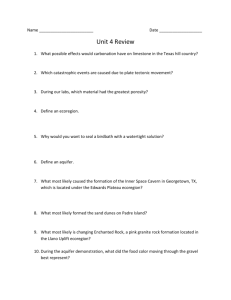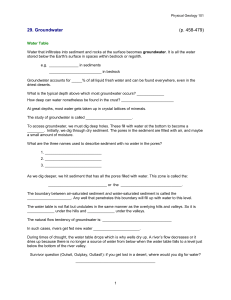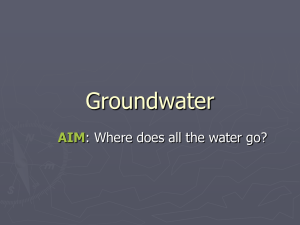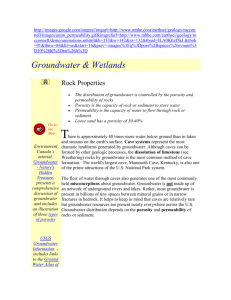Lect. 29
advertisement
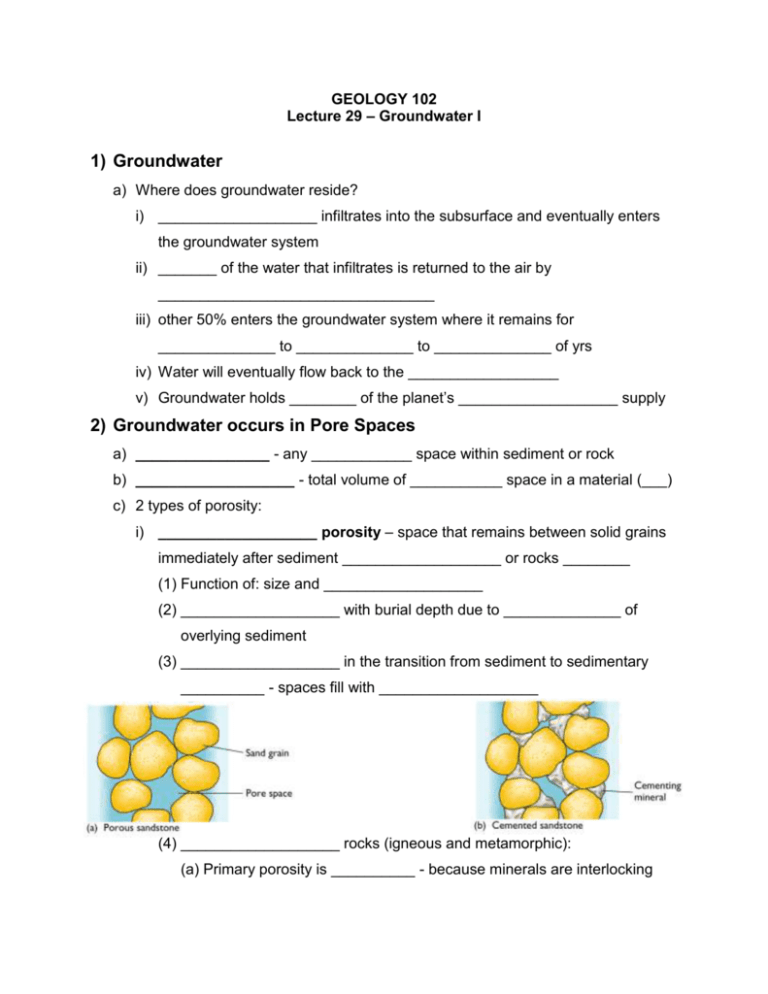
GEOLOGY 102 Lecture 29 – Groundwater I 1) Groundwater a) Where does groundwater reside? i) ___________________ infiltrates into the subsurface and eventually enters the groundwater system ii) _______ of the water that infiltrates is returned to the air by _________________________________ iii) other 50% enters the groundwater system where it remains for ______________ to ______________ to ______________ of yrs iv) Water will eventually flow back to the __________________ v) Groundwater holds ________ of the planet’s ___________________ supply 2) Groundwater occurs in Pore Spaces a) ________________ - any ____________ space within sediment or rock b) ___________________ - total volume of ___________ space in a material (___) c) 2 types of porosity: i) ___________________ porosity – space that remains between solid grains immediately after sediment ___________________ or rocks ________ (1) Function of: size and ___________________ (2) ___________________ with burial depth due to ______________ of overlying sediment (3) ___________________ in the transition from sediment to sedimentary __________ - spaces fill with ___________________ (4) ___________________ rocks (igneous and metamorphic): (a) Primary porosity is __________ - because minerals are interlocking (b) _______________ and _____________ provide pores (5) Highest in clastic sediments: (a) Sands: ___________________ (b) Sandstone: 10-20% (c) Limestone: ___________________ (d) Clay: 45-55% ii) ___________________ porosity - ________ pore space in rocks created sometime _________ the rock first formed (1) Creation of secondary porosity: (a) joints and ___________________ (b) dissolution and ______________ of minerals (common in limestone) 3) Permeability a) ___________________ - the ability of a material to ________ fluids to _________ through interconnected pores i) Controlled by: (1) ________________ of conduits (2) ____________ of conduits (3) route of conduits ii) Permeable material – water flows ______________ iii) Impermeable material – water flows ______________ or not at all b) Porosity and permeability are NOT THE SAME: i) A material whose pores are _________________ can have _________ porosity and _________ permeability (1) Mudstone: _________ porosity, _________ permeability (2) Poorly sorted conglomerate: _________ porosity, _________ permeability c) Aquifer - sediment or rock that _____________ water easily (______________) i) _________ porosity and permeability d) Aquitard - sediment or rock that ___________ transmit water easily (____________________) i) ______________ the motion of water ii) _________ porosity and permeability e) Aquiclude - does not transmit water ____________ f) Types of aquifers: i) ___________________ aquifer – aquifers that intersect the _______________ of the Earth (1) Water can percolate down directly from the _____________ (2) Water can also ___________ to the surface ii) ___________________ aquifer – aquifers that are separated from the surface by an ___________________ (1) Water is ________________ from the surface 4) The Water Table a) 2 realms of groundwater: i) Zone of ___________________ (unsaturated zone) – pores are filled with _________________ and ___________________ ii) Zone of ___________________ (saturated zone) – pores are filled with ______________ b) __________________________ - the top of the zone of ___________________, separates the 2 zones c) _____________ of water table varies with location i) Typically a subdued ____________ of surface ___________________ ii) Can be at the land surface (i.e. stream, marsh) iii) In ____________ regions – typically within a few ______________ of the ground surface iv) In ____________ regions – may lie tens of meters to _______________ below the surface d) Rainfalls effect: i) Level ___________ during a ________ season or a ___________________ ii) Level ___________ during a ________ season or a ___________________ iii) If the water table ___________ below the floor of a river or lake, the river or lake ___________________ (1) ___________________ stream – a nonpermanent stream, flows only during storms when _________________ > ________________ e) Topography: i) Shape of water table _____________ the shape of the overlying ___________________ (1) Groundwater moves very slowly and it cannot quickly assume a __________________ surface ii) Head (h) – the elevation of the surface of the water table above a __________________ horizon f) 5) Groundwater Flow a) Groundwater does not stand still – it ______________ b) Zone of aeration - water percolates ________________ down due to the force of _________________ c) Zone of saturation - water flows due to pull of ___________________ and due to differences in ___________________ d) Pressure i) Unconfined aquifer - ______________ is caused by the weight of overlying _____________ (not overlying rock/sediment) (1) ___________________ of pressure depends on the ___________ below the water table (2) If the water table is not ___________________ - pressure varies with location (a) Groundwater feels greater pressure under the __________, where the water table is _____________ (3) Difference in pressure and force of _______________ causes groundwater to follow a curved path (4) Flows from regions where the water table is __________ (under a hill) to regions where the water table is __________ (below a valley) (a) ________________ differences drive water __________________ e) Recharge area – location where water __________ the ground i) Flow direction has a ___________________ trajectory ii) Locally, occur at the _______ of a ____________ f) Discharge area – location where water __________ the ground i) Flow direction is ___________________ to the surface ii) Locally, occur in the valley _______________ g) __________ of groundwater flow: i) Typical rates – 0.01 – 1.4 m/day (_________________________) ii) Slow because: (1) Percolating through a ______________ network of _______________ (2) Follows a convolute path (3) Travels a _______________ distance (4) _______________ between conduit wall (mineral) and _______________ iii) Not always the same rate, controlled by: (1) _____________________ of the material (a) _______________ permeable > _______________ permeable (2) slope of the water table (a) _______________ the slope, the faster water moves (b) Greater _______________ difference between _______________ and _______________ areas iv) Determined by “_______________” water with dye or _______________ element v) Use ________________________ dating to determine the age of water h) Hydraulic Gradient (HG) - _______________ of the water table HGh/d i) h = _______________ of the water table ii) d = horizontal _______________ between 2 points i) Discharge (Q) – the _______________ of water flowing past a point in a _______________ time Q=KIA i) Q = _______________ ii) K = ______________________________ (controlled by _______________ and fluid’s _______________) iii) I =HG= hydraulic _______________ iv) A = _____________________________ area through which water is passing j) Equation is referred to as ______________________________ i) Groundwater flow is faster through very _______________ rocks than it is through _______________ rocks ii) And is faster where the water table has a _______________ slope than a _______________ slope 6) Groundwater Chemistry Groundwater contains ____________ derived from the ____________________ of rock through which the groundwater passes. Concentration of ions (________________) is controlled by __________________ and pressure. - warm water contains more dissolved __________ than cold water under great pressures at depth - water under great _________________ at depth can hold more dissolved _____ than water at the earth’s surface Presence of dissolved ions affects the value of water for human use ________________________ - forms when groundwater ________________ limestone or dolomite, then contains Ca+ and Mg+ ions Carbonate minerals will _____________ to form the “scale” that ________ pipes Also difficult to generate ___________ _______ when washing with hard water




